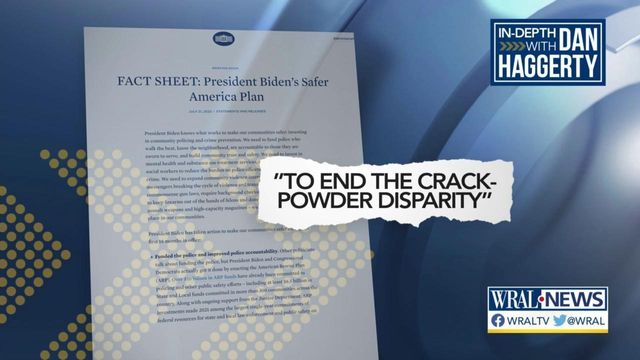In Depth with Dan: Explaining sentencing disparities between offenses for powder cocaine and crack cocaine
WRAL anchor/reporter Dan Haggerty explained the sentencing disparities between offenses for powder cocaine and crack cocaine.
Posted — UpdatedLast week on WRAL Evening News, I anchored a segment about President Joe Biden’s new “Safer American Plan.”
While discussing the proposal, there is a part I would have said better. It surrounds a decades-old controversy.
“To end the crack-powder disparity” has long been viewed by some people as a racist policy. It’s one that enforces stricter penalties for “crack,” which I said, was more prevalent in Black communities compared to “powder,” which I said was more prevalent with white people.
A viewer named Joseph wrote in and said, “Dan, who says powder cocaine is the cocaine of choice by white folks, while crack cocaine is the cocaine of choice by Black folks? Is there some study you can point the public to that makes up your statements on cocaine preferences by race?”
I replied by telling Joseph I probably spoke too loosely. The topic is more complicated than race alone.
“Maybe you could acknowledge being a bit too cavalier on that point in a future broadcast,” Joseph wrote back. “Good luck!”
NYU conducts study on power cocaine and crack use in the US
“We did find that Blacks were at higher risk for crack use until controlling for other socioeconomic factors and that Blacks tend to use at higher frequencies,” the study found. “Compared to whites, racial minorities were at low risk for powder cocaine use, and Hispanics were at low risk for crack use.”
The study found that socioeconomic status was the biggest indicator of who was most likely to use crack. It also highlighted several other findings, including:
- Crack users were at higher risk for lifetime arrest than powder cocaine users
- Racial minorities were at low risk for powder cocaine use
- Blacks were not at risk for crack use when controlling for socioeconomic status
- Higher education and family income were negatively associated with crack use
- Crack users tend to be of lower socioeconomic status than powder cocaine users
Spread of crack in the 1980s across the US and sentencing disparities
Crack came onto the scene in the 1980s, spreading quickly across the country, specifically in low-income, Black communities. The spread often happened in big cities. There are many theories why.
Crack is very cheap and very addictive considering it’s cocaine mixed with baking powder.
North Carolina Central University Law Professor Irving Joyner explained some of the repercussions from the crack epidemic the ‘80s.
“The crime rate went up exponentially all over the place, murder rates increased tremendously, robbery and all other kinds of crimes that were associated with people trying to obtain money to handle their addiction,” Joyner said.
The federal government made the penalty for crack worse than for powdered cocaine. Many people at the time approved of the strict sentencing.
You had a lot of fear also in African American communities because a lot of African-Americans were pushing for these more serious more severe punishment because they wanted to rid their neighborhoods of the kind of exploding criminal incidents that were occurring there,” Joyner said.
In Depth With Dan
Related Topics
• Credits
Copyright 2024 by Capitol Broadcasting Company. All rights reserved. This material may not be published, broadcast, rewritten or redistributed.





